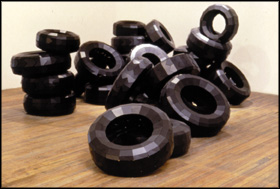In a world based on exchange, our living spaces are shared with objects that invade and govern them. The object is a nodal point where our relations to the world and to others are concentrated. In order to preserve a free logic of desire, a non-performative functionality, an enchantment and magic that does not equate with homogenisation, our lifestyles and our values must constantly be measured against a commercial and fetishistic logic.
The exhibition Objects of Desire, Objects of Transaction intends to create situations that challenge the viewers’ relations and values attached to everyday and consumer objects. It brings together a number of contemporary art practices involved in the object and its operations at various levels of projections and fantasy. The exhibition spaces are set up to create ambiguity between commercial and art gallery displays. This type of presentation partakes in the distancing and questioning of the object’s status as already produced by the artists’ works.
The works of James Carl play directly on this simulation of the commercial display of mass-produced objects. Tires, rice cookers, and oversized cigarette lighters made out of brightly coloured coroplast are assembled on shelves or piled on the floor. These very ambiguous art objects invoke Warhol’s Brillo boxes, engaging with recycled goods and everyday consumer objects while questioning the enormous production of domestic waste and the utilisation of resources . Placing these objects in relation to others such as the Stanley Cup or the iconic outline of a carton of French fries underlines the fetishistic relation we have with objects.
Claudie Gagnon’s massive accumulations of second hand store glassware take us into a world of enchantment and fascination. Lit from the inside, they recall the magnificence of a chandelier or mountain made of ice or glass. The banal and common object is instantly transposed to a baroque and playful universe not so far from Christmas fantasies or wedding rites. In Gagnon’s work, particularly her tableaux vivants, the second hand object is a motor of poetic narration; in her curiosity cabinet models, it is the source for a rediscovery of the fantastic. The object, liberated from its functionality, re-infused with the unusual.
Liquidation Niko et ses amis, by Nicolas Baier, refers to a kind of inventory of the domestic environment and its everyday objects. Photographic images of different formats are installed on the floor, on the wall, in the space, blown up, in series, or in a grid, and depict magnified objects or details of objects, truncated bodies, decorative motifs and textured surfaces. This evokes the chaos of inventory liquidations or garage sales, but is in fact articulated in a complex and flexible way through the grid structure and its references to modern art. Everything is interchangeable and valued for being part of a “system of objects” that filters our relation to the world and to others. Here we find the real issue of representation.
In Darboral (inner ubiquity and cohabitation), Massimo Guerrera establishes the object as motif and result of interaction and exchange. Here we find raw materials and ergonomic objects and objects whose functions appear to be problematic, making reference to clothing, prostheses, furniture, and simple containers of food to be offered to the visitor. A large number of photographs depict the encounters and performances that have arbitrated the fabrication of these objects, and have become themselves the objects of manipulation and transformation. Against the de-realised logic of corporations and commerce, Guerrera poses issues of proximity, encounters, and creativity. The object is difficult to contemplate — it designates and interrogates you, it solicits you and invites you to manipulate it. It is fundamentally valued as an indicator of uncommon potentialities.
From desire to transactions of all types, the object is a mirror of our interactions and our social issues.
Everyday objects, consumer objects, valuable objects, recycled objects, exchange objects… Objects of curiosity, objects of projection, objects of desire, fetishized objects… Collectors’ objects, objects of culture, objets of interaction...
Jacques Doyon
Translated by François Dion and Jen Budney
-
Friday, March 30, 2001 to Saturday, May 12, 2001
Opening- Thursday, August 23, 2001
